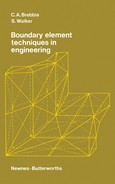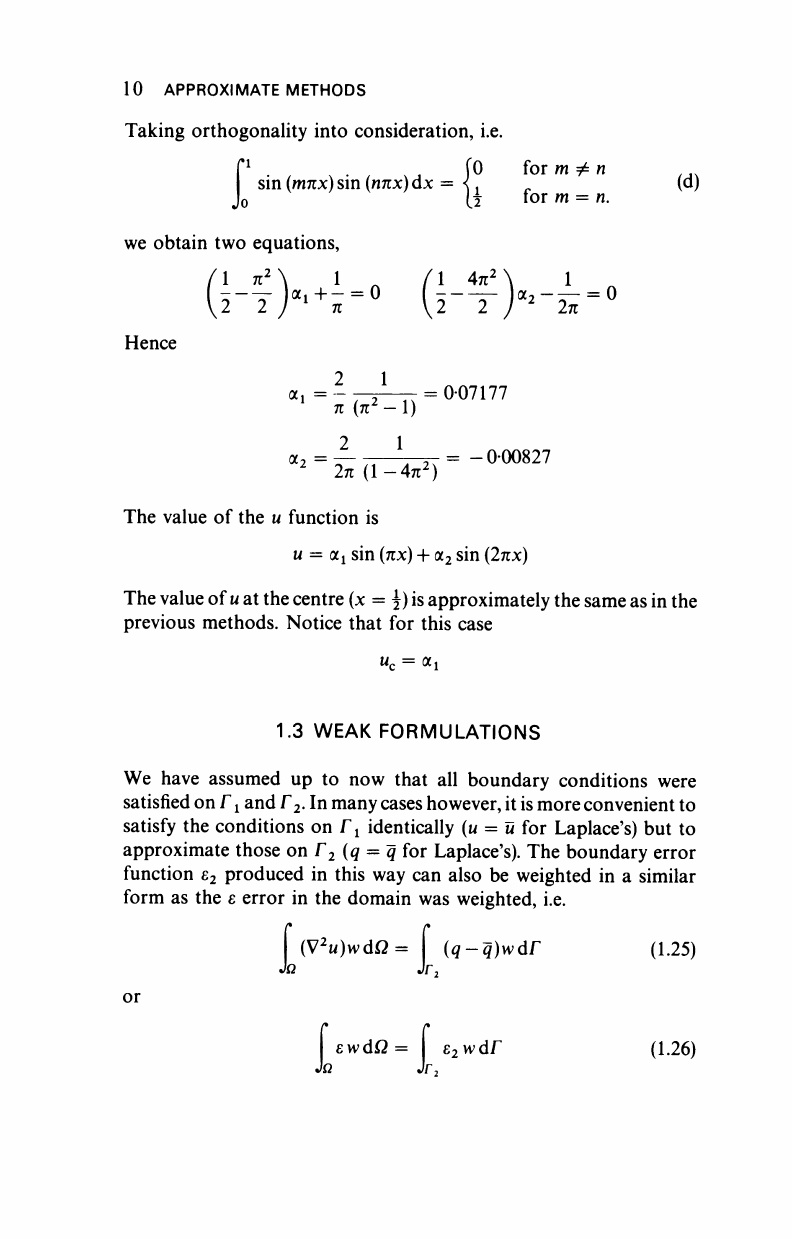
10 APPROXIMATE METHODS
Taking orthogonality into consideration, i.e.
ί
1
^ *
� for m ^ n
/A
.
sin
(mux) sin (ηπχ)
ax =
<
. _ (d)
j (j for m = n.
we obtain two equations,
/l π
2
1
Hence
1 π
2
1
ft
/l 4π
2
1
n
α
ι
a
2
2 1
2
~1.
Π
-i)
1
007177
-= -000827
The value of the u function is
u = a
x
sin (πχ) + a
2
sin (2πχ)
The value of
u
at the centre (x = £) is approximately the same as in the
previous methods. Notice that for this case
1.3 WEAK FORMULATIONS
We have assumed up to now that all boundary conditions were
satisfied on
Γ i
and
Γ
2
.
In many cases however, it is more convenient to
satisfy the conditions on Γ
χ
identically (u = ü for Laplace's) but to
approximate those on Γ
2
(q = q for Laplace's). The boundary error
function ε
2
produced in this way can also be weighted in a similar
form as the ε error in the domain was weighted, i.e.
(V
2
«)wdO= (q-q)wdr (1.25)
Jß Jr
2
or
■i.
ενάΩ= |
e
2
wdr
(1.26)
to
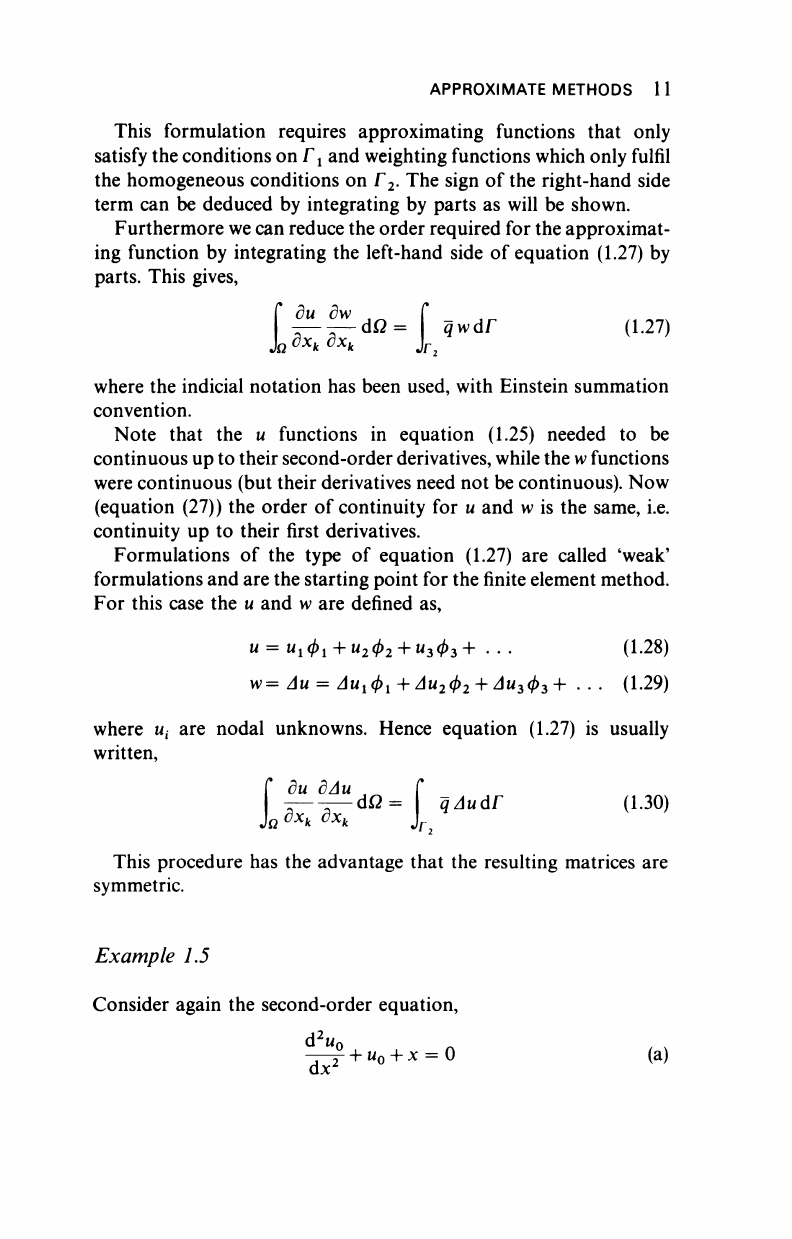
APPROXIMATE METHODS 11
This formulation requires approximating functions that only
satisfy the conditions on Γ
ι
and weighting functions which only fulfil
the homogeneous conditions on Γ
2
. The sign of the right-hand side
term can be deduced by integrating by parts as will be shown.
Furthermore we can reduce the order required for the approximat-
ing function by integrating the left-hand side of equation (1.27) by
parts.
This gives,
du dw
1Λ
, άΩ =
h dx
k
dx
k
qwdr (1.27)
where the indicial notation has been used, with Einstein summation
convention.
Note that the u functions in equation (1.25) needed to be
continuous up to their second-order derivatives, while the
w
functions
were continuous (but their derivatives need not be continuous). Now
(equation (27)) the order of continuity for u and w is the same, i.e.
continuity up to their first derivatives.
Formulations of the type of equation (1.27) are called 'weak'
formulations and are the starting point for the finite element method.
For this case the u and w are defined as,
U =
Ι
ι
φ
ι
+M
2
02 +
w
3</>3+ . . . (1.28)
w= Au = Αιι
ί
φ
ί
+ Au
2
</>
2
+ Au
3
φ
3
+ ... (1.29)
where w, are nodal unknowns. Hence equation (1.27) is usually
written,
du dAu ,
—--—
άΩ
=
ο
dx
k dx
k
qAudr (1.30)
This procedure has the advantage that the resulting matrices are
symmetric.
Example 1.5
Consider again the second-order equation,
d
2
u
-_^ +
Mo
+
x =
0 (a)
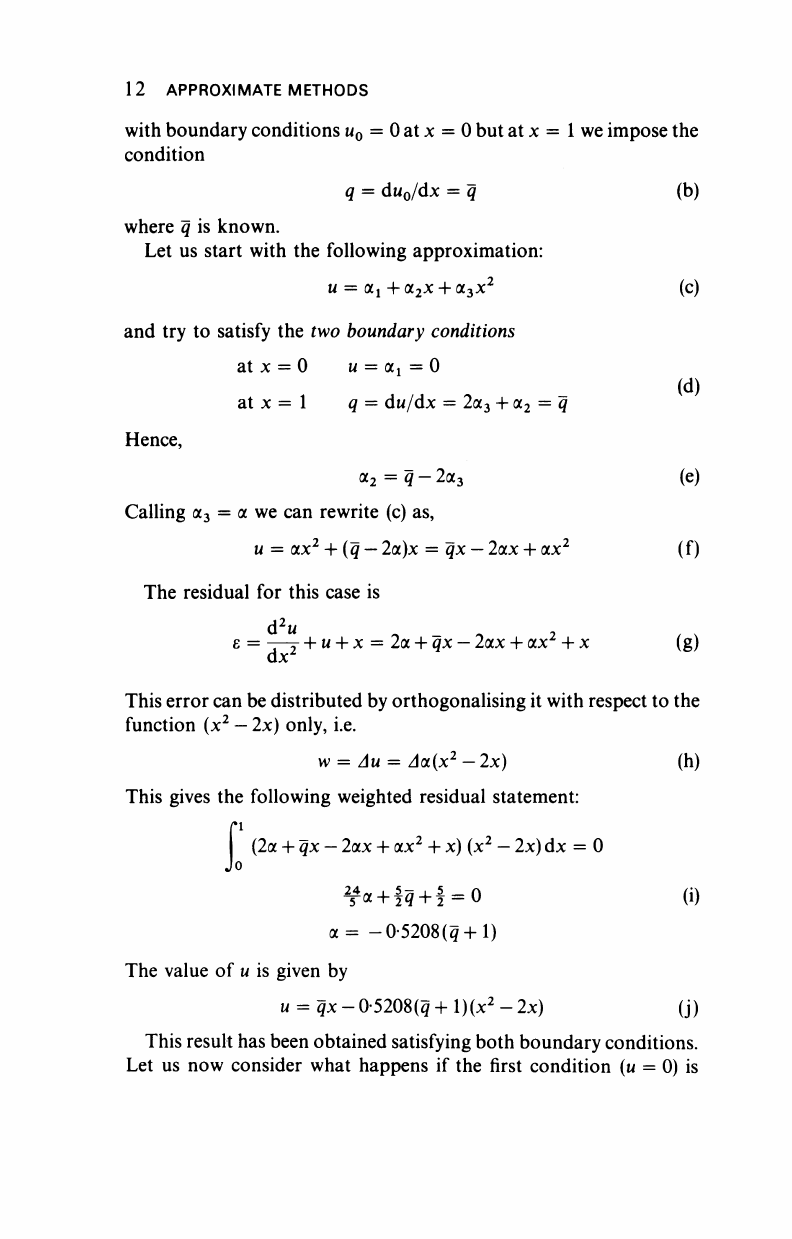
(d)
12 APPROXIMATE METHODS
with boundary conditions u
0
= 0 at x = 0 but at x =
1
we impose the
condition
q = du
0
/dx = q (b)
where q is known.
Let us start with the following approximation:
u = a
x
+a
2
x + a
3
x
2
(c)
and try to satisfy the two boundary conditions
atx = 0 u =
OL
1
= 0
at x = 1 q = du/dx = 2a
3
+ a
2
= g
Hence,
a
2
=
<j
- 2a
3
(e)
Calling a
3
= a we can rewrite (c) as,
u =
ccx
2
+ (q
—
2a)x = qx
—
2ax + ax
2
(f)
The residual for this case is
ε = —y +
w
+ x = 2a + ^fx
—
2ax -f ax
-h
x (g)
dx
z
This error can be distributed by orthogonalising it with respect to the
function (x
2
—
2x) only, i.e.
w = Au =
AOL(X
2
— 2x) (h)
This gives the following weighted residual statement:
n
(2a + qx
—
2ax + ax
2
+ x) (x
2
— 2x)
dx = 0
i
¥a
+
!^
+
! = 0 (i)
a= -0-5208(^ + 1)
The value of u is given by
u = qx- 0-5208(3 + l)(x
2
- 2x) (j)
This result has been obtained satisfying both boundary conditions.
Let us now consider what happens if the first condition (u = 0) is
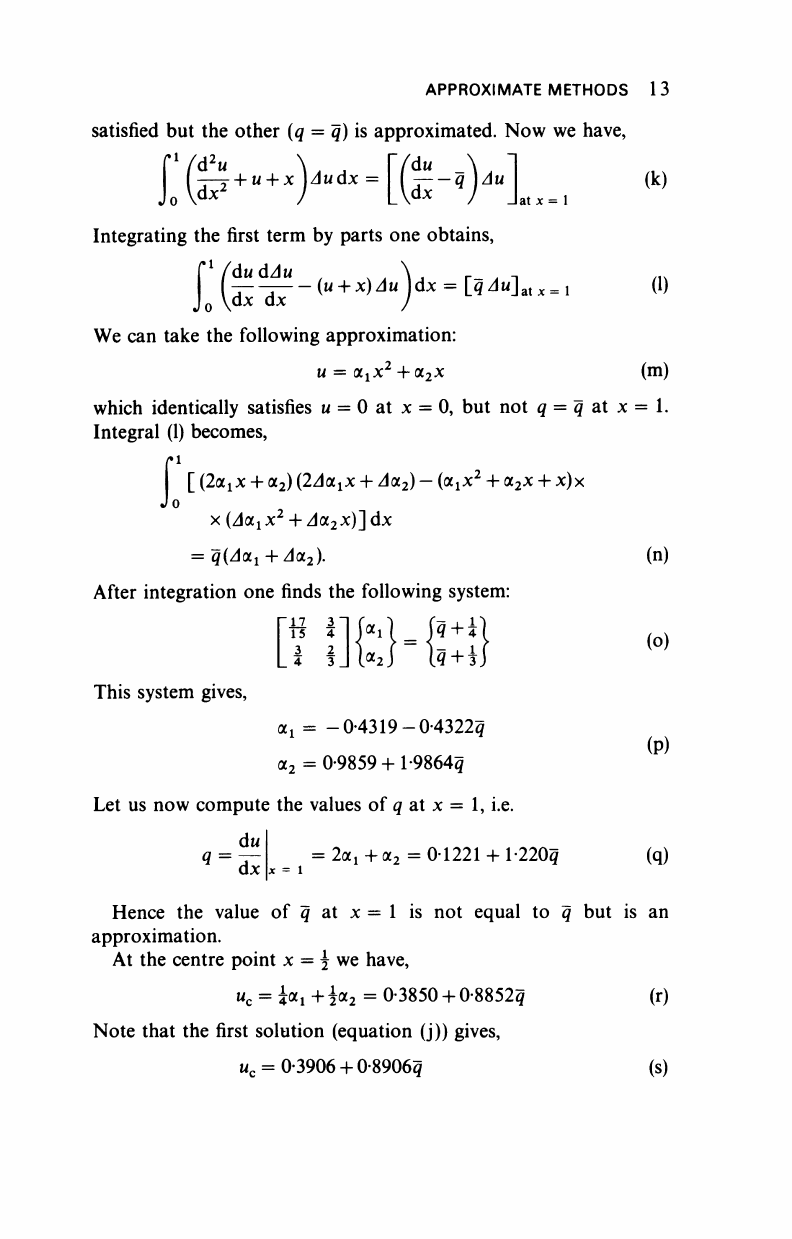
APPROXIMATE METHODS 13
satisfied but the other (q = q) is approximated. Now we have,
Γ
1
i
d2u
LW
+U
+ x Mwdx =
dx
.,)..]
x=
1
Integrating the first term by parts one obtains,
Γ(:
du dAu
dx dx
— (u + x)Au ldx = [<?^M]
at x =
1
We can take the following approximation:
u =
cc
1
x
2
-l·
a
2
x
(k)
(1)
(m)
which identically satisfies u = 0 at x = 0, but not q = q at x = 1.
Integral (1) becomes,
[ (2a
x
x + a
2
) (2/doqx +
A(x
2
) —
(a
x
x
2
+ a
2
x + x)x
i
1
Jo
x
(Α&γΧ
2
+ Ja
2
x)]dx
= 4(^0^ +
AOL
2
)·
After integration one finds the following system:
Li fJW t«+ij
This system gives,
a
1=
-0-4319-0-43225
a
2
= 0-9859+
1-98645
Let us now compute the values of q at x = 1, i.e.
du
q
~dbc
= 2α
1
+α
2
= 01221 + l-220g
(n)
(o)
(P)
(q)
Hence the value of q at x = 1 is not equal to q but is an
approximation.
At the centre point x = j we have,
"c = i«i + 2*2 = 0-3850 + 0-8852^
Note that the first solution (equation (j)) gives,
u
c
= 0-3906 + 0-8906^
(r)
(s)
..................Content has been hidden....................
You can't read the all page of ebook, please click here login for view all page.
